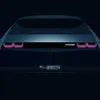Here are the top cars from the Tokyo Motor Show 2019
The general theme in the 46th edition of Tokyo Motor Show has been electric mobility, with a focus on clean energy
The 46th edition of the Tokyo Motor Show finally began and with it a plethora of new models and concepts. With clean energy as the key theme, here are some of the best offerings seen at the Tokyo Motor Show 2019.
Honda Jazz (Honda Fit)

Honda has unveiled the latest generation model of the Honda Jazz, but only as a hybrid. It has an EV-styled nose with a small opening in the front. Unlike its competitors around the world, which is busy going ahead with aggressive design philosophy, the Honda Jazz focuses on comfort and practicality.
The fourth-generation Honda Jazz has full LED headlamps with U-shaped light guide and square-shaped projectors. The air intake is at the bottom while the C-shaped fog lamps add a sporty touch. The rear has wraparound horizontal tail lamps with twin U-shaped light guides that remind you of the BMW i3. Interiors include a bigger and newer infotainment system with slim, vertical air-con vents.
Powering the Honda Jazz is a setup similar to the CR-V hybrid. However, unlike the SUV, the Jazz is expected to get a 1.5-litre engine, assisted by an electric motor. Honda may even introduce a 1.0-litre turbocharged engine as an option in certain markets.
While the new Honda Jazz may not head to India anytime soon, the platform will be the precursor of the new generation Honda City. We also expect its new powertrain system to make it to the new Honda City.
Nissan Ariya

The Nissan Ariya shows how future electric Nissan vehicles will look. Tracing its origins to the Nissan IMx concept showcased at the same venue two years ago, the Ariya has a crossover inspired look. We expect a production version to hit the streets in a couple of years.
Nissan Ariya is 4.6 m long and 1.92 m wide - shorter than the Nissan X-Trail but wider. The modular architecture will be used by all members of the Renault-Nissan-Mitsubishi alliance. This will allow multiple shapes, sizes, electric motors, and battery packs. A thin LED light in the front blends with the grille, which, in turn, pays tribute to Nissan’s V-motion design philosophy.
Interiors use a minimalistic layout with bare minimum buttons for the infotainment system. Nissan Ariya has a flat floor thanks to the lack of transmission tunnel seen in a conventional internal combustion engine. Dual electric motors are mounted on each axle to offer all-wheel drive with performance claimed to be at par or even better than most sports cars. Besides that, the Nissan Ariya is promised to have excellent cornering performance and traction on slippery surfaces.
Mitsubishi MI-Tech concept

Destined to be a small hybrid-electric SUV, Mitsubishi promises to deliver unparalleled driving pleasure and confidence over any kind of terrain. The Mitsubishi MI-Tech is driven by a new PHEV drivetrain; a four-motor electric four-WD system and advanced driver-assist and preventive safety technologies. It also gets T-shaped headlights embedded in the front end while an aluminium skid plate is placed on both sides to protect the body.
The rear-end of the body gets a large and bold hexagon shape. Besides that, a T-shaped tail lamp shares the same design pattern used in the front end, as do the rear bumpers. Mitsubishi MI-Tech utilises an evolved version of the company’s Super All Wheel Control integrated vehicle dynamics control system along with a Quad Motor four-wheel drive system.
Mitsubishi MI-Tech also comes equipped with a Human Machine Interface (HMI), which displays information detected through sensing technology, including advanced optical sensors. All this is projected on the windshield via augmented reality.
Lexus LF 30

Want to know what cars in 2030 might look like? That is exactly what Lexus promises with the LF 30. According to the senior management at the Toyota owned brand, the Lexus LF 30 is not directly linked to a specific product. It rather symbolises the electrification vision of the company. However, the model you see above is technically based on a new electric platform that will underpin future Lexus and Toyota electric vehicles from 2022.
Lexus LF 30 measures 5,090 mm in length, 1,995mm in width, and 1,600 mm in height. Powering the car is a solid state 110kWh battery that can charge at 150kW and offer a range of around 500 km. All this is packaged in a body weighing 2,400 kg makes the Lexus LF 30 something worth looking forward to. Power output is a claimed 543 PS while torque is said to be a sky-high 700 Nm! A 0 to 100 kmph is a claimed 3.8 seconds!
At the Tokyo Motor Show, Lexus also announced that by 2025, it will have electrified versions of all models. In fact, the company is aiming for the sales of electric vehicle models to outpace those of conventional internal combustion engine products.
Mazda MX-30

Mazda has taken wraps off its first-ever production electric vehicle Mazda MX-30. The car gets unique suicide rear doors, which are very similar to the ones seen in the Mazda RX-8. Interiors include a three-spoke steering wheel and a touchscreen infotainment system sitting at the top of the dashboard. Also, a secondary touchscreen display is present to operate the climate control functions.
Based on the company’s e-SkyActiv platform, Mazda MX-30 gets an autonomous emergency braking with turn-across traffic detection. The latter utilises a combination of a millimetre-wave radar and forward-facing camera. Besides that, an advanced Blind Spot Assist system is also on offer. Mazda engineers have also created an electronic sound system inside the Mazda MX-30. This system is synchronised to the motor’s torque in sound frequency and pressure.
Maxda MX-30 is powered by a 35.5 kWh battery pack, which is claimed to be good for 200 km of usage. Performance figures stand at 142 PS of power and 263 Nm of torque.
(Edited by Saheli Sen Gupta)








